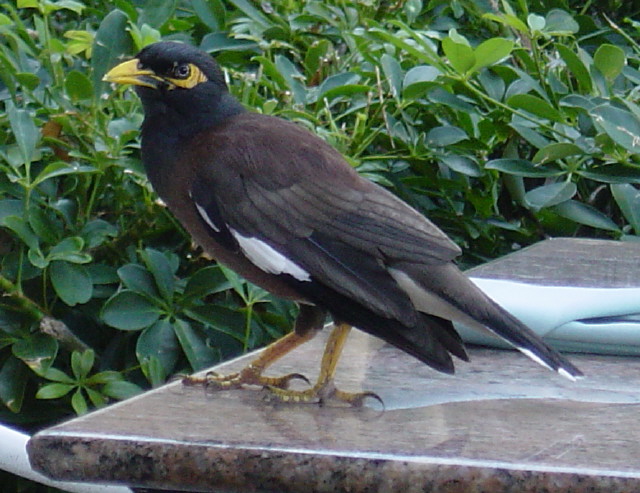Common Myna (Acridotheres tristis) - Wiki Common Myna
From Wikipedia, the free encyclopedia
[Photo] Common Myna (Acridotheres tristis) found on big island of Hawaii. Photograph: Kowloonese http://en.wikipedia.org/wiki/User:Kowloonese
| Permission is granted to copy, distribute and/or modify this document under the terms of the GNU Free Documentation License, Version 1.2 or any later version published by the Free Software Foundation; with no Invariant Sections, no Front-Cover Texts, and no Back-Cover Texts. A copy of the license is included in the section entitled "GNU Free Documentation License". |
The
Common Myna,
Acridotheres tristis, is a
myna, a member of the
starling family. This bird is a common resident breeder in tropical southern Asia from Afghanistan to India and Sri Lanka. It is also known as the
Indian Myna or Talking
Myna for its ability to mimic human speech.
It has extended its range into southeast Asia, and has been introduced widely elsewhere, including South Africa, Israel, Hawaii, North America (especially in southern Florida), Australia (where it is considered to be one of the top 100 most invasive pests and voted one of the most unpopular [1]) and New Zealand.
This abundant passerine is typically found in open woodland, cultivation and around habitation. The
Common Myna builds a nest in hole in a tree or wall. The normal clutch is 4-6 eggs. They are popular as cage
birds for their singing and "speaking" abilities.
This 25 cm long bird has dark brown body and wing plumage, with large white wing patches obvious in flight. The head and throat are dark grey. The bill, bare skin around the eyes and strong legs are bright yellow. The sexes are similar.
Mynas mate for life.
Like most
starlings, the
Common Myna is omnivorous. It feeds on insects and fruits and discarded waste from human habitation. It forages on the ground among grass for insects, and especially for
grasshoppers from which it gets the generic name
Acridotheres, "
grasshopper hunter". It walks on the ground with occasional hops.
The song includes croaks, squawks, chirps, clicks and whistles and it often fluffs its feathers and bobs its head in singing. The
Common Myna screeches warnings to its mate or other
birds in cases of predators in proximity.
http://en.wikipedia.org/wiki/Common_Myna| The text in this page is based on the copyrighted Wikipedia article shown in above URL. It is used under the GNU Free Documentation License. You may redistribute it, verbatim or modified, providing that you comply with the terms of the GFDL. |
